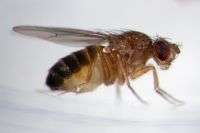September 29, 2011 report
Researchers discover fruit fly aphrodisiac

(PhysOrg.com) -- People, mostly of the male persuasion, have been searching the world for a true aphrodisiac for pretty much all of recorded history, unfortunately, the search has been mostly fruitless, which makes this latest discovery by a group of biologists all the more intriguing. As noted in their paper published in Nature, it appears the common fruit fly has found for itself, a substance that we humans can only dream about; a substance than when smelled, causes the smeller to engage in mating. Unfortunately, at least for the fruit fly, the stuff only works on males.
The substance in question is actually two: phenylacetic acid and phenylacetaldehyde; both of which are commonly found in ripe fruit. It seems that smelling either substance activates the sensory pathways that lead to courtship, which for fruit flies seems to make sense. It’s commonly known that the female fruit fly lays its eggs in ripe fruit, thus, it seems pretty obvious why the male developed a certain sensitivity to the chemicals found in it. For the fruit fly, it’s the perfect environment. They can eat then mate and then after a while the females can lay their eggs, all in one convenient place. In some respects it’s rather reminiscent of the visual sensory activation that occurs in male humans when looking at certain images that are tied to their own mating rituals.
The sensory pathways in fruit flies that lead to courtship have been known for a while, but it wasn’t until this study was conducted that it became known that they could be activated by substances outside of the flies themselves. Previously, it had been assumed that such pathways would be activated by pheromones generated by flies of the opposite gender, as is the case with other animals. In fact, the team hadn’t really set out to make the connection; they were simply studying the sense of smell in Drosophila melanogaster. As their research continued, however, it became clear that something in the outside environment was activating the sensory pathways, and after further study they found it was the substances in the fruit. Of note is the fact that the chemicals are only present in ripe fruit, which we humans detect as a sweet odor. For fruit flies, it’s important because the female only lays eggs in fruit that has had time to ripen (or rot).
After more research, the team found that the sensory pathway activation only worked for males, which led to speculation that it was the males’ behavior that led to females laying their eggs in ripe fruit.
Because this is the first time a connection has been found between chemicals in the environment in which an organism lives, and sexual activation, the results of this research will almost certainly set off research in other animals to see if they respond in similar ways to chemicals in their surroundings.
More information: An olfactory receptor for food-derived odours promotes male courtship in Drosophila, Nature (2011) doi:10.1038/nature10428
Abstract
Many animals attract mating partners through the release of volatile sex pheromones, which can convey information on the species, gender and receptivity of the sender to induce innate courtship and mating behaviours by the receiver. Male Drosophila melanogaster fruitflies display stereotyped reproductive behaviours towards females, and these behaviours are controlled by the neural circuitry expressing male-specific isoforms of the transcription factor Fruitless (FRUM). However, the volatile pheromone ligands, receptors and olfactory sensory neurons (OSNs) that promote male courtship have not been identified in this important model organism. Here we describe a novel courtship function of Ionotropic receptor 84a (IR84a), which is a member of the chemosensory ionotropic glutamate receptor family6, in a previously uncharacterized population of FRUM-positive OSNs. IR84a-expressing neurons are activated not by fly-derived chemicals but by the aromatic odours phenylacetic acid and phenylacetaldehyde, which are widely found in fruit and other plant tissues7 that serve as food sources and oviposition sites for drosophilid flies8. Mutation of Ir84a abolishes both odour-evoked and spontaneous electrophysiological activity in these neurons and markedly reduces male courtship behaviour. Conversely, male courtship is increased—in an IR84a-dependent manner—in the presence of phenylacetic acid but not in the presence of another fruit odour that does not activate IR84a. Interneurons downstream of IR84a-expressing OSNs innervate a pheromone-processing centre in the brain. Whereas IR84a orthologues and phenylacetic-acid-responsive neurons are present in diverse drosophilid species, IR84a is absent from insects that rely on long-range sex pheromones. Our results suggest a model in which IR84a couples food presence to the activation of the fruM courtship circuitry in fruitflies. These findings reveal an unusual but effective evolutionary solution to coordinate feeding and oviposition site selection with reproductive behaviours through a specific sensory pathway.
© 2011 PhysOrg.com

















